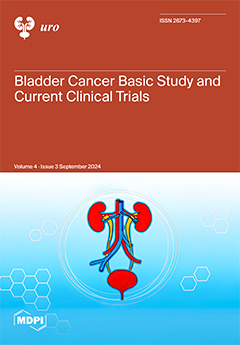Background: To compare perioperative outcomes and trifecta rates between laparoscopic and robotic partial nephrectomies (PN) using the Hugo™ RAS System, a study was conducted between October 2022 and September 2023.
Methods: Twenty-two patients underwent minimally invasive PN for cystic renal tumors
[...] Read more.
Background: To compare perioperative outcomes and trifecta rates between laparoscopic and robotic partial nephrectomies (PN) using the Hugo™ RAS System, a study was conducted between October 2022 and September 2023.
Methods: Twenty-two patients underwent minimally invasive PN for cystic renal tumors at our institution (group A: RAPN = 6; group B: Laparoscopic PN = 16). The trifecta was defined as the coexistence of negative surgical margin status, no Clavien–Dindo grade ≥ 3 complications, and eGFR decline ≤ 30%. Continuous variables were presented as median and IQR and compared using the Mann–Whitney U test, while categorical variables were presented as frequencies (%) and compared using the χ
2 test. For all statistical analysis, a two-sided
p-value < 0.05 was considered statistically significant.
Results: All patients successfully underwent off-clamp minimally invasive PN without the need for conversion or additional port placement. Group A showed a lower preoperative eGFR rate and a higher clinical tumor size, while group B displayed a higher number of male patients and bilateral lesions. However, these differences were not statistically significant (all
p > 0.1). Regarding perioperative data, group A showed a lower operative time (79.5 vs. 134.5 min,
p = 0.01), while group B showed a higher trend of benign histology (62.5% vs. 33.3%). All the other perioperative data were comparable between the two groups (all
p > 0.2). The rate of trifecta achievement was 83.3% and 87.5% (
p = 0.80) for group A and B, respectively.
Conclusion: This study emphasizes the advantages of RAPN over laparoscopic procedures in terms of operative time. Extensive experience in Laparoscopic PN could be a key factor when approaching RAPN learning curve.
Full article



